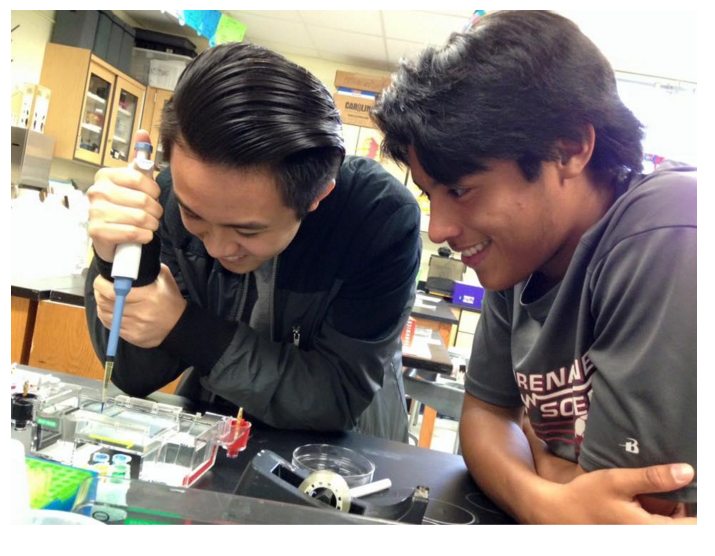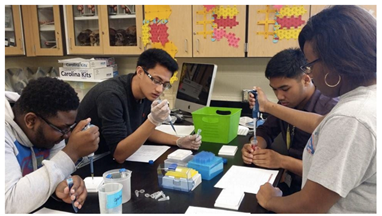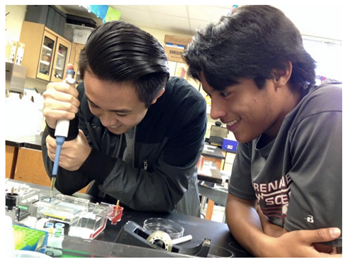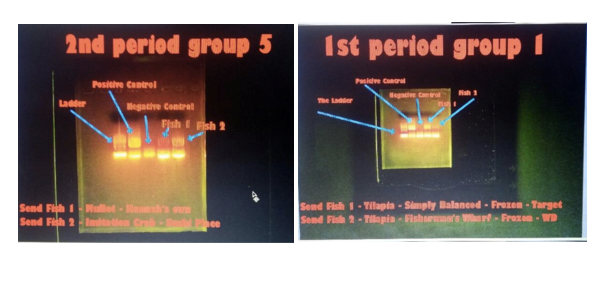Fishy Business in AP Biology: A PowerUP Jax Success Story
1/14/2016

Gayle Fiser, winner of the 2015 Innovation in Education Award, shares journal entries chronicling her PowerUP Jax project with Darnell-Cookman Middle High School students. The project focused on fish DNA barcoding that required students to visit sushi restaurants with their families. PowerUP Jax’s lead sponsor, Community First Credit Union believes that innovation in the classroom should be rewarded. Continue reading to learn more about this project! - Ale'ta Turner
Tuesday, December 1
Six days off for Thanksgiving holidays makes you slow to get moving on the return to school. Kids walk in the door like they have been in a self-induced coma from Thanksgiving leftovers. I, too, felt that slowness this morning until I opened my sacred bin of biotechnology materials. This is absolutely one of the most exciting times that I have during my AP Biology teaching year. My energy was then power-boosted to a level that made me hit the post-holiday ground running. My excitement in delivering information to the students and sharing the days ahead, in turn made them excited, also. Two things we talked about and viewed animations today were about PCR (Polymerase Chain Reaction) and running gels (Gel Electrophoresis). We are so fortunate to have these resources at Darnell-Cookman.
Wednesday, December 2
The learning objective for our College Board Curriculum requires the students be able to explain how heritable information can be manipulated using common technologies. They must be able to construct these explanations based on evidence produced through these scientific practices and also make claims and predictions with models. Questions on exams are often oriented around a scenario using gel electrophoresis, restriction enzyme analysis of DNA, or Polymerase Chain Reaction. These concepts can be hard for a student to grasp conceptually. To be able to apply these concepts to relevant and interesting topics makes it easier for students to learn. Crime scene forensics and paternity analysis are two topics that use all of these technologies and trigger student interest in learning more. So today, I taught them about the how the CODIS system that they see on crime scene television shows actually works. They now seem to have a better grasp on how DNA is manipulated and cut with restriction enzymes, copied with PCR, and how the fragments are separated in gel electrophoresis.
Thursday, December 3
Today we talked about the lab for next week and its relevance to the economy, sustainable fishing, and our health. We also discussed the overall general idea and instructions for the lab. To continue to prepare, we had our first day of training with the micro-pipettors. These are very precise and expensive devices and we go through all of the dos and don’ts for using before beginning. The students used protocols developed by University of Florida for micro-pipetting practice that results in a pre-determined design. Students enjoy learning with this high-tech piece of equipment. Instructions were given to the “Fish Sample Collection” students for their weekend excursions out to get our samples.

Friday, December 4
Today, we took the next steps to get ready for the Fish DNA Barcoding Lab. Learning how to micro-pipette into a gel is a nerve-wracking feat for high school students. Hands shake, anxiety levels rise, breathing stops, but in the end, they demonstrate perfection and skill. They now are ready to use all of this equipment in the Fish DNA Barcoding lab.. The purpose of the lab is our point of interest, not how to use equipment, so we take baby steps to prepare and feel confident before we begin.

Saturday, December 5 and Sunday, December 6
Students are out collecting samples. They have been given plenty of materials and instruction needed to prevent contaminating samples. A huge family gathering was arranged by one sample collecting student.
Monday, December 7, 2015
Day 1 of the Fish DNA Barcoding Lab went well. So far I have about 6 hours of lab prep behind me to prepare for this lab. But all the pain disappeared when all of the students came in prepared for the job ahead of them and excited about our “high tech” experience that we were about to undertake. Students brought in fish samples from trips out to Jacksonville grocery stores and sushi restaurants. Today we extracted the DNA from the fish samples. Organization and attention to detail were at their best today. Students read over the procedure for today this past weekend and came into class with plenty of “what” questions. “What does that do?” What does this mean?” We walked through 90 minutes of procedures today, every group moving together as a part of one larger cohesive unit. Their micro-pipetting skills learned last week were commendable. They learned to use two more pieces of equipment today, the micro-centrifuge and the vortex. We are very close to being ready to running the PCR on our samples tomorrow.
Tuesday, December 8, 2015
Day 2 of the Fish DNA Barcoding Lab. Today PCR (Polymerase Chain Reaction) became a real experience instead of just a slide in a presentation or a statement of knowledge needed in the curriculum.
Wednesday, December 9, 2015
The students pipetted their samples into the gel wells and ran their samples. A supportive member of the FSCJ Biotechnology Department, Mr. Chris Bush, from the downtown campus brought over their portable UV Trans-illuminator/Photo-documentation System so that the students could view their samples and see immediately if they were successful in extracting DNA from their fish sample. It was a very exciting moment as each group placed their samples on the light and viewed bright lights of success. They prepared samples to mail off for sequencing. We will use the results the analysis in our upcoming Evolution unit as we explore comparing DNA sequences, evolution, and bioinformatics.
Thursday, December 10, 2015
We viewed each group’s photo of their gel sample and identified and explained what the students were in fact, looking at in the picture. The gel electrophoresis samples that indicated as successful were chosen to be sent for sequencing and analysis.

Tuesday, December 22, 2015
I mailed off the sequence samples for analysis. I have no idea what to expect. This is the first time we have ever tried anything this advanced in our high school lab.
Thursday, December 24, 2015
The sequencing has been completed and after Christmas I will run the sequences through the NCBI’s (National Center for Biotechnology Information) BLAST (Basic Local Alignment Search Tool) program to identify the samples. Our samples will be compared to organism’s genomes that have been sequenced in this bank.
Tuesday, December 29, 2015
It was time to take on and conquer how to download and open these sequences. After I discovered the appropriate tools to be able to copy the sequences and insert them into BLAST, I shared this exciting information with my students on our group Facebook page. Identifying labels were placed on the fish so the students would know which one was their group’s fish. This was a very exciting day for me as the end of this huge academic undertaking was approaching. I was very happy to see the results that confirmed the identification of our fish, but also the proof of hard work and diligence on the part of my students to surpass the expected limits of high school science. The results for First Period Group 1 was tilapia!
Through funding provided through PowerUP Jax’s lead sponsor, Community First Credit Union, Jacksonville Public Education Fund and friends contributing to our crowdfunded PowerUP Jax project, my AP Biology students experienced an upper division college laboratory opportunity. This experience and the skills they learned will be remembered as they begin and continue their college education. Some may have discovered new interests that may affect their career paths. As a teacher and advocate for my students, to stretch the limits of classroom experiences by seeking funding, writing proposals, and preparing advanced learning settings, provides students with opportunities that surpass what is required and pushes them ahead of the rest of competition in their future. The confidence they gained is worth every cent awarded and every moment of my time invested.
Currently PowerUP Jax is accepting applications until January 22. Visit www.powerupjax.org to learn more about past award winners, FAQs and more.
---

Gayle Fiser,
AP Biology Teacher
Darnell-Cookman Middle High School